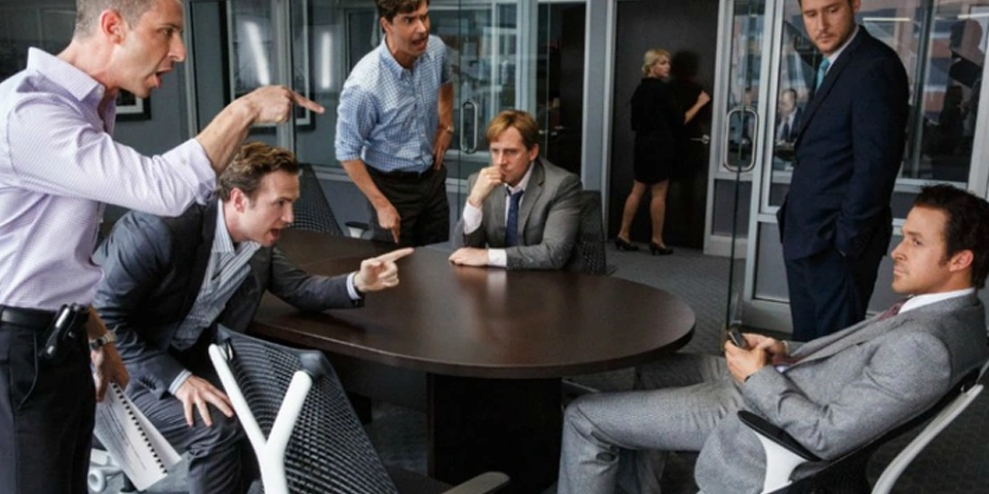The movie is being lauded for its attempt to tackle tricky concepts, but will any of it stick?
Most Americans probably hadn’t heard the phrase “mortgage-backed securities” until around 2008, when the subprime-mortgage crisis erupted and sent the U.S. financial system into chaos.
But what exactly happened? That’s the central question of the film The Big Short, an adaptation of Michael Lewis’s 2010 book about a handful of Wall Streeters who uncovered the underlying problems in the mortgage market and bet against (or shorted) the securities made up of subprime debt before all hell broke loose. These underdogs become the winners of the financial crisis. Kind of.
The Big Short is immensely entertaining. The movie makes a serious effort to capture some of the more outlandish Wall Street personas: The socially awkward genius, Michael Burry (Christian Bale); the crank, Mark Baum (Steve Carell); the slimy wanna-be millionaire, Jared Vennett (Ryan Gosling); and the recovering ex financier, Ben Rickert (Brad Pitt). And to put some (likely overemphasized) heart and morality into the story, there is a focus on the dismay of these characters (Carell in particular) as they realize how dire the circumstances they are profiting off of really are.
But perhaps the most ambitious undertaking of the film is to make the jargon and financial concepts behind the crisis accessible, and almost sexy. That last part may be why it’s receiving so much award buzz. (The New York Times financial journalist Adam Davidson was the film’s technical director.) Most movies about finance and Wall Street focus heavily on culture and excess. Remember the cocaine fueled parties of Wolf of Wall Street? The Big Short injects a healthy dose of that, all while urging the audience to understand what really happened and why.
For those who vividly remember the crisis, the movie can be stressful at times, showing all the points at which safety mechanisms failed to kick in. For those who don’t remember or weren’t paying close attention, it’s a good primer on how the recession started. For both groups, it’s worth watching. Below, we discuss the film and what it’s trying to show.
Bourree Lam: Even during the first five minutes of the film, it was clear that Adam McKay (director) and Charles Randolph (co-screenplay writer) were going to explain a lot of financial concepts and products in two hours. The film starts with Lewis Ranieri, the “godfather” of mortgage backed securities, at Solomon Brothers in the 1970s. It then moves on to follow the cast of characters in the mid-2000s on Wall Street (and in Michael Burry’s case, San Diego) as they discover hints of the subprime mortgage crisis and the “big short”—betting against the U.S. housing market and waiting for it to implode. The characters all come to this conclusion through different discovery paths, and in that way I felt the film was thrilling in the way it followed their journeys.
Gillian White: Throughout the film viewers get a primer in collateralized debt obligations (CDOs), tranches, credit-default swaps, mortgage-backed securities, and synthetics. That’s a lot, especially for those who aren’t well versed in financial jargon. In the end, I felt like the effort was a mixed bag. But while I was annoyed by the premise of someone actually bringing a Jenga set into a meeting (and in fact, all the finance people in my theatre audibly groaned along with me), I did think that the use of the structure was probably a visual tool. Essentially, Gosling uses a Jenga tower to show how tranches work: that even top-rated securities couldn’t withstand the failure of lower-rated securities, on which the tower and many CDOs were built. If the lower-rated securities failed, everything would crumble.
Lam: I agree, even though during that scene I mumbled “no one does this in real life!” I thought it was a really helpful illustration of tranches. I found the cutaway explainers less strong: the Margot Robbie bubble-bath scene where she explains mortgage-backed securities was funny, but ultimately a bit confusing. The Anthony Bourdain scene about fish stew and collateralized debt obligation sort of worked. And I never thought I’d see behavioral economist Richard Thaler and Selena Gomez in the same room, but I actually thought they explained synthetic CDOs pretty well.
I admire that the filmmakers took on a really tough task: explaining finance is not easy or fun. Especially something as complicated as the subprime-mortgage crisis. But the film works even if the concepts aren’t completely explained: Even if you don’t understand what a credit default swap is, you get that Burry is going to the various banks to make a deal they think is insane—but he thinks will pay off. You get to be in on the deal, whether you know what the deal actually is or not.
White: Right, so there for instance, I didn’t think they did a fantastic job of explaining why precisely everyone was laughing at Burry, yet also willing to do business with him. And then what precisely that deal entailed, and why his company was forced to pay premiums (which enraged his boss and clients). That is of course, a lot of nuance and jargon, but it felt a little glossed over after they went into such painstaking detail leading up to it.

